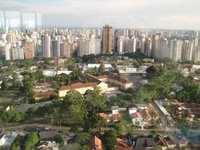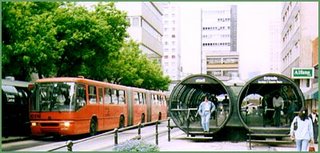The city of first priorities
 I first heard of Curitiba while working at the Dudley Street Neighborhood Initiative (DSNI) in Roxbury, Massachusetts. I was curious to see if some of their successes in comprehensive planning were transferable to a community like ours. Although I never got a chance to visit Curitiba myself, I did have the opportunity to hear Bill McKibben give a talk describing his impressions of the city and its people -- which really is the next best thing to being there. (GW)
I first heard of Curitiba while working at the Dudley Street Neighborhood Initiative (DSNI) in Roxbury, Massachusetts. I was curious to see if some of their successes in comprehensive planning were transferable to a community like ours. Although I never got a chance to visit Curitiba myself, I did have the opportunity to hear Bill McKibben give a talk describing his impressions of the city and its people -- which really is the next best thing to being there. (GW)by Donella Meadows
RESIDENTS OF CURITIBA, BRAZIL, think they live in the best city in the world, and a lot of outsiders agree. Curitiba has seventeen new parks, ninety miles of bike paths, trees everywhere, and traffic and garbage systems that officials from other cities come to study. Curitiba's mayor for twelve years, Jaime Lerner, has a 92 percent approval rating.
There is nothing special about Curitiba's history, location or population. Like all Latin American cities, the city has grown enormously -- from 150,000 people in the 1950s to 1.6 million now. It has its share of squatter settlements, where fewer than half the people are literate. Curitiba's secret, insofar as it has one, seems to be a simple willingness of the people at the top to get their kicks from solving problems.
Those people at the top started in the 1960s with a group of young architects who were not impressed by the urban fashion of borrowing money for big highways, massive buildings, shopping malls and other showy projects. They were thinking about the environment and about human needs. They approached Curitiba's mayor, pointed to the rapid growth of the city, and made a case for better planning.
The mayor sponsored a contest for a Curitiba master plan. He circulated the best entries, debated them with the citizens, and then turned the people's comments over to the upstart architects, asking them to develop and implement a final plan.
Jaime Lerner was one of the architects. In 1971 he was appointed mayor by the then military government of Brazil. He has since served two more four-year terms (nonconsecutive, as required by Brazilian law) -- one of them appointed, the other elected.
Given Brazil's economic situation, Lerner had to think small, cheap, and participatory -- which was how he was thinking anyway. He provided 1.5 million tree seedlings to neighborhoods for them to plant and care for. ("There is little in the architecture of a city that is more beautifully designed than a tree," says Lerner.) He solved the city's flood problems by diverting water from lowlands into lakes in the new parks. He hired teenagers to keep the parks clean.
Lerner prefers rehabilitating built-up areas to spreading the city outward. He converted a former warehouse into a theater and an abandoned glue factory into a community center. He met resistance from shopkeepers when he proposed turning the downtown shopping district into a pedestrian zone, so he suggested a thirty-day trial. The zone was so popular that shopkeepers on the other streets asked to be included. Now one pedestrian street, the Rua das Flores, is lined with gardens tended by street children.
Orphaned or abandoned street children are a problem all over Brazil. Lerner got each industry, shop and institution to "adopt" a few children, providing them with a daily meal and a small wage in exchange for simple maintenance, gardening or office chores. Brazil forbids child labor; Lerner says, "By law, a child mustn't work, but society looks the other way when he goes hungry or homeless or works for a drug trafficker."
Another Lerner innovation was to organize the street vendors into a mobile, open-air fair that circulates through the city's neighborhoods.
Concentric circles of local bus lines connect to five lines that radiate from the center of the city in a spider web pattern. On the radial lines, triple-compartment buses in their own traffic lanes carry three hundred passengers each. They go as fast as subway cars, but at one-eightieth the construction cost.
The buses stop at Plexiglas tube stations designed by Lerner. Passengers pay their fares, enter through one end of the tube, and exit from the other end. This system eliminates paying on board, and allows faster loading and unloading, less idling and air pollution, and a sheltered place for waiting -- though the system is so efficient that there isn't much waiting. There isn't much littering either. There isn't time.
Bus fares are low (twenty to forty cents per ride, with unlimited transfers), but the system pays for itself. Private companies own and operate the buses and keep part of each fare. The city gets the rest to pay for roads and terminal and to buy up old buses, which are refurbished as classrooms, day-care centers, and clinics.
Curitiba's citizens separate their trash into just two categories, organic and inorganic, for pickup by two kinds of trucks. Poor families in squatter settlements that are unreachable by trucks bring their trash bags to neighborhood centers, where they exchange them for bus tickets or for eggs, milk, oranges and potatoes, bought from outlying farms.
The trash goes to a plant (itself built of recycled materials) that employs people to separate bottles from cans from plastic. The workers are handicapped people, recent immigrants, alcoholics.
Recovered materials are sold to local industries. Styrofoam is shredded to stuff quilts for the poor. The recycling program costs no more than the old land-fill, but the city is cleaner, there are more jobs, farmers are supported, and the poor get food and transportation. Curitiba recycles two-thirds of its garbage -- one of the highest rates of any city, North or South.
Curitiba builders get a tax break if their projects include green areas. The city has a hotline to report industrial polluters. In spite of strict environmental laws, 341 major industries, including Fiat, Pepsi and Volvo, have plants or offices in Curitiba.
Jaime Lerner says, "The dream of a better city is always in the heads of its residents. Our city isn't a paradise. It has most of the problems of other cities. But when we provide good buses and school and health clinics, everybody feels respected. The strategic vision leads us to put the first priorities on the child and the environment. For there is no deeper feeling of solidarity than that of dealing with the citizen of tomorrow, the child, and the environment in which that child is going to live."
The city of first priorities. (Curitiba, Brazil). Donella Meadows. Whole Earth Review n85 (Spring 1995)






0 Comments:
Post a Comment
<< Home